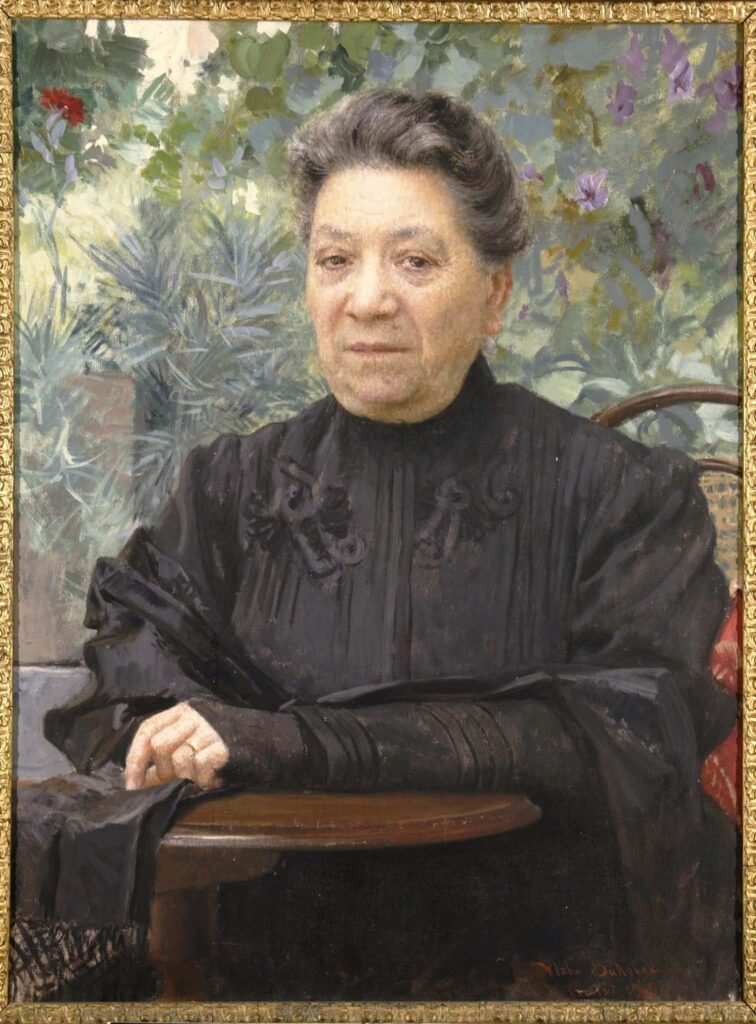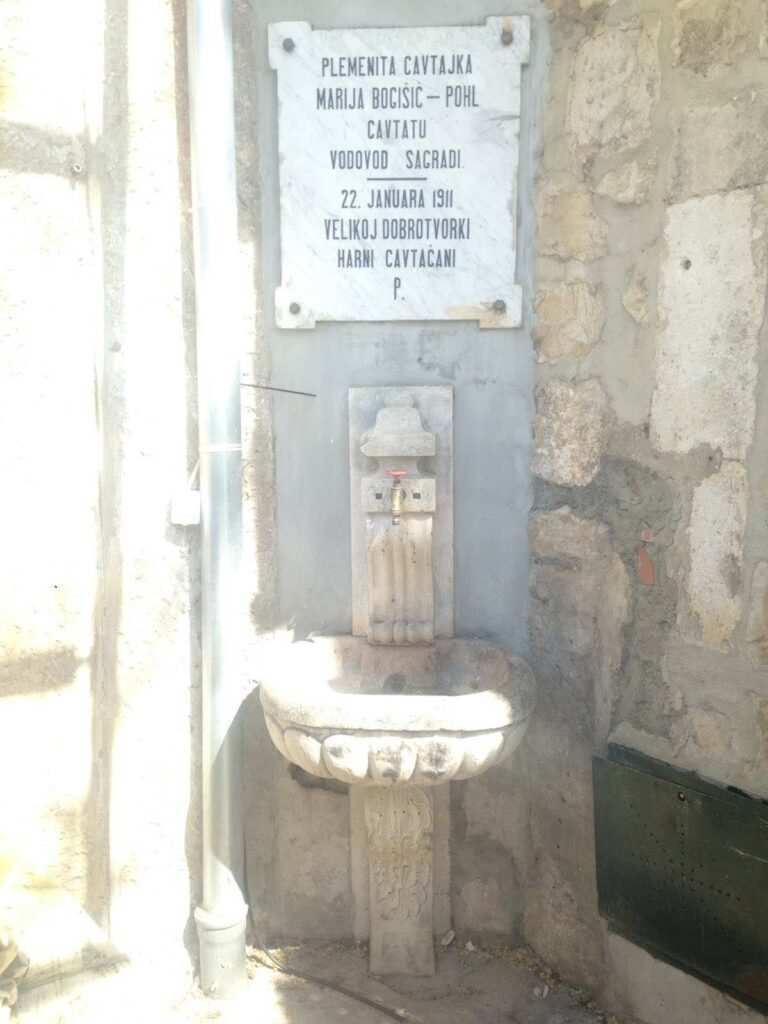Marija Bogišić Pohl was born in Cavtat on 24th January 1837, in a family from the village of Mrcine in Konavle. She was the daughter of Vlaho Bogišić and Marija Miljan and the younger sister of Baldo Bogišić. Her mother passed away when she was only one month old, and her father remarried after a few months, which resulted in Marija being raised by her stepmother, Nike Capor. She spent her childhood in Cavtat, graduated from a public school and married in 1858. She married Ivan Pohl, a military surgeon of Czech descent living in Cavtat. They had no children.
She is best remembered as Baldo Bogišić’s sister, and as a woman who, following her brother’s death, worked on preserving his legacy, which she brought to Cavtat from Paris, and managing the family money, which she would often donate. The fact that 100 years have passed since her death provided a perfect opportunity to briefly review her significance for Cavtat, as well as her legacy.
Many of her friends, including painter Vlaho Bukovac and lawyer Đuro Bijelić, helped Marija preserve and display her family’s legacy. Bijelić was an especially close friend of hers, while also acting as her assistant and secretary. In fact, the majority of the letters and concepts that Marija would send to Bogišić’s associates or her own friends were written by Bijelić, while she would only provide her signature. That was also the case with the letters sent to Bukovac, in which she expressed her desire to contribute to the betterment of Cavtat. An excerpt from a letter dated 21st November 1917 serves as an example of this: `You, my good sir, know that I am a Cavtat native through and through, and that I will do everything in my power for the benefit and progress of our town.‘
In 1903, she financed the renovation of the façade of the Our Lady of the Snow Church with money from her family’s legacy; for this donation, she and Đuro Bijelić received the papal decoration. In that church there is a plaque expressing gratitude to her as a person who saved this local shrine from the impending ruin. Another project financed by Marija, also marked by a memorial plaque, was the construction of a water supply system for Cavtat, which was completed in 1911. The local priest recorded the following in the parish chronicle: `The opening of the water supply system, which was carried out thanks to the donation of Mrs Marija Bogišić-Pohl, who bequathed money from her late brother’s legacy, followed on 22nd January 1911. The blessing ceremony of the fountain on the shore was also held on that day. In the same year, the pastor noted that the local benefactress, Mrs Marija Bogišić Pohl, paid for a new bell tower clock worth 3,400 Czech koruna, which was procured from Brno.‘
Apart from fostering the betterment of Cavtat, Marija also took special care of preserving the memory of her late brother. She was involved in the construction of a monument in his honour and in the decoration of his tomb at the St. Roko Cemetery, while her donation initiated the decoration of a park in Dubrovnik that would bear his name. The former Society for the Development of Dubrovnik and its surroundings suggested to Marija that she donate money for a fountain that would be placed in the park on Ilijina glavica in memory of Baldo Bogišić. In 1909, she donated 10,000 Czech koruna to the Society for this purpose. The donated sum would suffice for the construction of a fountain, which was negotiated with Ivan Meštrović, but it was insufficient for either the designing of the park or for the construction of the park’s water supply. This prompted the Society to invest money in the completion of the park, which is still named after Baldo Bogišić to this day. However, there is one matter in which she did not respect her late brother’s decision. Namely, she agreed to the demolition of one of their two houses in Cavtat. The house in question was connected to the old city gates from the age of the Republic of Dubrovnik. Its ground floor was a rental space for shops; moreover, it held sentimental value for Baldo Bogišić, who did not allow its demolition. After his death, Marija relented under the pressure and allowed the demolition, while the Municipality of Cavtat committed to erecting a monument in Baldo Bogišić’s honour at that very location. From 1909 to 1911, donations were collected for the construction of monument, while Bukovac suggested to Marija and Đuro Bijelić to commission the services of Petar Pallavicini, a young sculptor from Korčula. Pallavicini’s plaster model of the monument is kept in the pinacotheca of the St. Nikola Parish in Cavtat, along with a Pallavicini’s portrait bust of Marija Bogišić Pohl.
Until the end of her life, Marija was involved mostly in preserving her brother’s numerous valuable collections. In order to avoid leaving anything to chance, in her will she explicitly requested that her brother’s entire collection remain in Cavtat. The aforementioned collection contains approximately 20,000 volumes of various literature, with the incunabula collection being its most valuable articles, approximately 10,000 drawings and engravings, a valuable numismatic collection, an archaeological collection gathered by the Epidaurus Society, various maps, weapons, ethnographic artefacts and Baldo Bogišić’s personal correspondence letters with numerous notable contemporaries. Although an idea was discussed for these valuable artefacts to be stored in the Franciscan monastery in Cavtat, the Yugoslav Academy of Sciences and Arts adopted the collection in 1955 and made it accessible to the general public in the Rector’s Palace in Cavtat on 29th April 1958, respecting Bogišić’s wish to keep the entire collection in Cavtat.
The issue of the Narodna svijest newspaper published on 25th February 1920 included the following quotes concerning the legacy of Marija Bogišić Pohl: `The deceased leaves behind not only the most beautiful, but also an eternal memory of herself in Cavtat with her abundant endowments and gifts.‘ She was buried with her husband Ivan Pohl in the St. Roko Cemetery in Cavtat in 1920. Even one hundred years after her death, she is remembered as a benefactor and visionary who dedicated her entire life and bequeathed all of her possessions to Cavtat.


